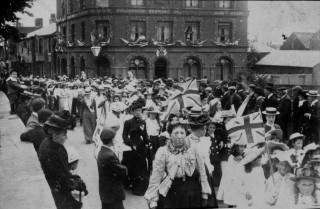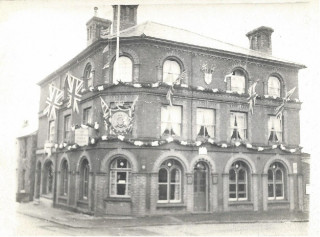About The Grosvenor Hotel c.1865 to c.1969
41 High St on the corner of the junction with Station Road. Now commercial premises.
Sue Glasspool
The Pub Trail Index – click here
Built when the railway came to Wivenhoe this imposing hotel /public house would have been seen as a threat to the old established pubs, for example The Falcon opposite, but they both existed for another century.
Early years 1860s to 1880s
Have you ever wondered why Victorian pubs are often situated on a street corner? John Eade, a Colchester builder, knew why and built four pubs / hotels on corners in Wivenhoe: The Station, The Park Hotel, The Live and Let Live and The Grosvenor, all of a very similar design.
By the mid-nineteenth century, with more regulation, pubs became purpose-built rather than being in an ordinary house – i.e. the publican’s front room where he sold home-brewed beer or bought-in beer in barrels with a tap.
Owners wanted their pub to stand out from a block of businesses on a street and get maximum profit by encouraging all classes. They introduced the public bar and the saloon bar and being on a corner meant that each could have its own entrance, keeping the “gentlemen” from the working class. The inside became more enticing with brass fittings, tiles, mirrors etc., similar to the gin palaces which the public liked but of which the authorities had despaired – it was better to encourage beer drinking rather than gin.
The Grosvenor was built by speculative builder John Eade just two years after the railway line opened. He purchased land, with help from the Colchester bankers Bawtree, Errington, Bawtree and Haddock (a name which comes up frequently in local deeds),which had been bought by the Tendring Hundred Railway Company; once the railway was built the company sold off any remaining unused plots. Eade saw that Wivenhoe was beginning a rapid period of change when it was becoming much more connected with the outside world; yachting visitors were arriving together with commercial travellers.
Immediately it was established, Eade put the hotel on the market, at an auction held at The Grosvenor, together with other properties he had recently built in the village. An advert in the Essex Standard (ES) of 10 August 1866 describes the hotel as containing:
“numerous commodious and well-arranged rooms and is fitted up with capital ale and wine cellars and a most thriving and increasing trade ……brick built stables, chaise house and yard…. The Hotel is let to Messrs Bridges and Co (Bridges Cuthbert & Co of Ipswich) on lease at £75 per annum. Property may be viewed on application to Mr Robert Burgess, at The Grosvenor Hotel”
Robert Burgess was the first licensee although on the 1871 census his occupation is builder and his wife, Eliza, is “Hotel Keeper”. Eliza died in 1873 and Robert gave up the licence; on the1881 census he is living with his mother in Park Road, as a carpenter/joiner.
It appears that John Eade still owned The Grosvenor at the time of his death in 1877. An abstracted deed dated 1879 shows his wife Elizabeth Eade’s title to a number of properties, including The Grosvenor, which are to be sold to a J.S. Barnes. In the 1881 census Elizabeth is listed as “Builder, employing 30 men and 4 boys” so she ran a substantial business.
1880s to 1920s
The position of the hotel in the heart of the village and its size made it a gathering point for larger events such as auctions, committee meetings, smoking concerts etc. All licensed premises at this time were tacitly agreed places for men only and mixed gatherings and events including children took place in church halls, or the school. Even social events known as ‘Teas’ were actually formal events for men only, comprising a meal followed by speeches, toasts and songs; the Parish Easter Tea was one such event usually held at The Grosvenor. A report in the Essex Standard on 12th May 1902 on that year’s Easter Tea says “An excellent repast was provided by host Bow.” It was not until 1904 with the opening of the Foresters Hall by the Ancient Order of Foresters that Wivenhoe gained a public hall.
The prominence of the pub also meant that official business was carried out there; for example, in 1880 an open Court for the Revision of the List of Voters for the East Essex Division was held there (Essex Standard 11th September 1880). A barrister would go on circuit to various centres to hear revisions to the list; as he was due at The Grosvenor at 4.30pm on Thursday 30th September and then at Manningtree at 10am the following day, perhaps he stayed overnight at The Grosvenor. The court at Wivenhoe also included lists for the surrounding villages, for example Alresford, Brightlingsea and Fingringhoe. The Grosvenor was ideally placed for rail, ferry and carriage travel for those qualified to register.
Peter Kay comments in his book Wivenhoe Pubs, “The licensees of the inns and hotels were, if of a suitable personal character, eligible to participate in the public affairs of the town alongside the gentry and professional classes.” This applied to the aforementioned Henry Bow who was the landlord for 10 years between 1898 and 1908. In the 1891 census he was living in East Ham working as a carpenter but in Wivenhoe, as a respected publican, he became a councillor for the Wivenhoe Urban District Council, only retiring when he left the village in 1908.
The Essex Standard of 26th May 1900 begins its report on the Wivenhoe celebrations following the Relief of Mafeking “Wivenhoe is known to be an extremely loyal and patriotic place.” And, if buildings could tell their story, The Grosvenor would agree. Situated on the main street near the church, it would have seen a constant stream of processions going past to celebrate jubilees, the Queen’s Birthday, Empire Day, Remembrance Day, ends of wars etc, and it is often the case that The Grosvenor appears in photos as a backdrop to these special events. Henry Bow was on the Coronation Committee organising the event to celebrate the accession of Edward VII and The Grosvenor was suitably decked out with flags and swags.
Henry was happy to greet people from anywhere in the world. Managing a hotel in a port meant that his guests may well be from abroad and in 1901 on the night of the census, a master mariner and a mercantile engineer from Greece were staying at the hotel.
However the main trade for Henry would be the daily sale of beer, wine and spirits. As photos from 1902 show, the hotel was now owned by the Colchester Brewing Co. and Henry’s name is written large on the front – BOW appears in letters about a foot high above the door.
1920s to close
The days of the big yachts coming to Wivenhoe came to an end when WW1 commenced, but in 1918 returning soldiers could still find work in the shipyards. These were the men who kept the pub going. 1926 saw the closure of the upstream shipyard and also Cox and King’s small shipyard downstream of Husk’s. There was a dramatic decrease in sales as brewery records show – an annual sale of 84 barrels of beer compared with 102 in 1925. This was a dismal time for those looking for work; a Labour Exchange opened in Alma Street and the queues – up to 400 men from Wivenhoe and neighbouring villages – stretched back to opposite The Grosvenor. Around 1930, with no visiting yachtsmen and little other demand, The Grosvenor gave up the accommodation side of the business. In 1933 Alfred Jackson became the licensee of The Grosvenor. In the book “Sea-Change,Wivenhoe Remembered” his son, Glendower, recalls the atmosphere of the pub:
“…as soon as the whistle blew they [the shipwrights} were in the pub.. .playing darts…they always sang songs. There would always be someone who could play… a little squeezebox. Always darts matches.”
In 1935 Ind Coope became the owners and the licensee from 1937 until 1951 was Charles Davis. Sales would have improved during WW2 as both shipyards were building ships for the Admiralty. Now everyone had a purpose and could find work. Earnings paid not only for the odd pint but also helped the war effort; in one month in 1942 Wivenhoe saved enough money to buy a tank and in 1943 the village raised enough for 4 Spitfires – over £15,000.
In 1955 The Grosvenor was put up for sale. It was bought by Tollemache Breweries of Ipswich, later Tolly Cobbold, but closed around 1969. There are now shops on the ground floor and offices above. As a Grade II Listed Building it has retained all its main features.
Links to other pages on this website:
- The Grosvenor Hotel
- The Grosvenor – later years
- Interview with Mr Glendower Jackson
- Jimmy Moore’s Grocery Shop
- Auctions at The Grosvenor Hotel in the 1800s
- The Landlords and Breweries of Wivenhoe’s beerhouses, public houses and hotels
General Sources:
- Abstract of the title of Mrs Elizabeth Eade. Lots 3 and 8. For J.S. Barnes, purchaser, dated 1879.
- Barton D, “Wivenhoe: its attractions, pleasures and eccentric natives”, Dick Barton Enterprises 1975.
- Butler N, “The Story of Wivenhoe”, Quentin Press Wivenhoe, 1989.
- Collins J, and Dodds J, “River Colne Shipbuilders”, Jardine Press 2009.
- Kay P, “Wivenhoe Pubs”, published by Peter Kay 2003.
- Thompson P, “Sea- Change, Wivenhoe Remembered” Tempus Publishing Ltd, 2006
The Pub Trail Index – click here

![Grosvenor c1900 [WMC] The Grosvenor's prominent corner position. Note the name of the landlord (H.Bow) above the door. c.1900 | Photo: Wivenhoe Memories Collection](https://www.wivenhoehistory.org.uk/wp-content/uploads/2020/09/Grosvenor-c1900-WMC-320x227.jpg)



![pub-grosvenor-[Terry Garland] The Grosvenor in 2020 with the brickwork now restored as befits this Grade ll listed building | Picture: Terry Garland](https://www.wivenhoehistory.org.uk/wp-content/uploads/2020/09/pub-grosvenor-Terry-Garland-320x240.jpg)






No Comments
Add a comment about this page